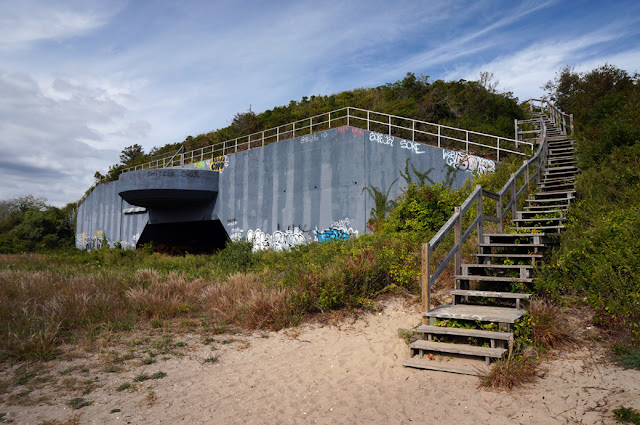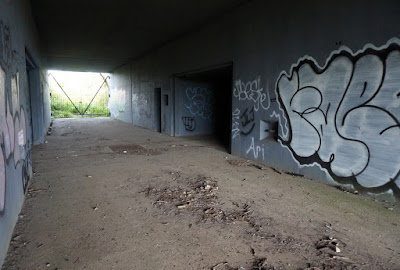 |
| Battery Harris East |
Intro
Located on the southwest end of the Rockaway Peninsula, Fort Tilden was an army base of 309 acres strategically located to defend New York Harbor. The base was built in 1917 as part of an emergency military buildup during WWI. The base began with smaller 12” gun batteries to defend against maritime threats but evolved over time to address new advances in military technology, as well as new types of warfare.[1] Although covered with dunes and vegetation today, most of the base was once an open landscape.[2] In 1974 military operations ceased and the base was turned over to the National Park’s Service for incorporation into the Gateway National Recreation Area. After being decomissioned nature was allowed to return the base's landscape to the natural state it's in today.[1][2]
 |
| Fort Tilden 16" Gun Emplacement |
 |
| View of Crew and Rails for Munition Supply from Barrel of 16" Gun (Photo Source: History of Fort Tilden at www.oocities.org) |
 |
| Nike Hercules Missile at Fort Tilden (Photo Source: Techbastard.com) |
 |
| Looking Out from Under Battery Harris East Bunker |
 |
| Looking Into the Battery Harris East Bunker |
 |
| Pill Box / Machine Gun Nest |
The fortifications and armament constructed during WWI were part of the Taft system of defense. Secretary of war William Taft outfitted U.S. defense fortifications with electric lights, motorized ammunition hoists, searchlights, telephone communications and observation posts for accurate targeting of enemy ships. After WWI anti-aircraft guns and camouflage were added to address the new threat from aerial attack. In the mid-1930s, prior to the Second World War, the depression era WPA constructed many additional buildings on the base. During WWII, larger, M1919MII 16" gun batteries were added and existing guns were fortified in concrete bunkers known as casemates, with additional protection and camouflage provided by a cover of sand and vegetation. From above the batteries are hidden within the dunes. In 1954-1955, during the Cold War, Fort Tilden’s defense capabilities were enhanced with additional anti-aircraft guns and Nike surface to air missiles.[3]
 |
| Fort Tilden Building |
 |
| Fort Tilden Building |
 |
| Fort Tilden Building |
 |
| Fort Tilden Building |
 |
| Fort Tilden Magazine Building |
Since the base was decommissioned much of its infrastructure, including large gun mounts on the beach, has been covered by sand dunes and maritime vegetation. Many of the remaining buildings have been unmaintained, vandalized and damaged by storms including Hurricane Sandy. The most impressive remaining structures include 4 large artillery bunkers known as Battery Harris East and Battery Harris West. One of the bunkers has an observation platform with public access. In addition to the bunkers there are pill boxes (machine gun nests) in the dunes behind the shoreline, a hanger, magazine buildings (for ammunition storage) and a generator building among others.[5]
The Park
If you visit Fort Tilden today, there are many types of park programs and facilities for you to take advantage of. The Rockaway Artist Alliance and the Rockaway Theatre Company offer cultural programming. “Tours and ranger-led programs highlight many great spots to see wildlife in the maritime forest”. The observation deck on top of one of the bunkers can be used for taking in panoramic views and bird watching.[4] For active recreation, the shoreline offers typical beach activities and there are athletic fields for soccer and baseball at the east end of the park.
Additional Photos
 |
| View from Observation Platform on top of Battery Harris East |
References:
- "A Detailed History of Fort Tilden" NationalParksService.gov
- Selvek, Christina & Auwaerter, John Cultural Landscape Report for Fort Tilden Olmstead Center for Landscape Preservation - National Park Service, Boston Massachusetts, 2005
- “Nike Missile Site NY-49 Fort Tilden New York” TechBastard.com
- “Fort Tilden” NewYorkHarborParks.com
- "The History of Fort Tilden" www.oocities.org
I love all the "secret" little places around and in New York area.....
ReplyDeleteThe pictures of buildings at Ft. Tilden are a snack bar (wooden building) and the officers shower and locker room (brick building) spent my early teens surfing, life guarding, flipping burgers and rolling in the dunes with Debbie K. From the end of school to Labor Day spent everyday on the beach sunup to past sundown. 1962-1970 Saw those missiles many times!
ReplyDelete